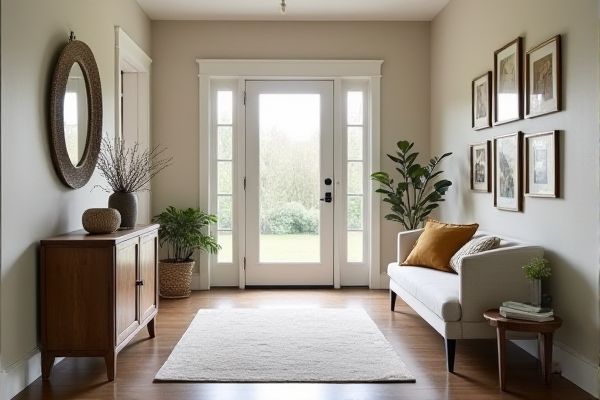
An entry table is designed to provide a practical and stylish surface near your doorway for keys, mail, and decor, while a sofa table typically sits behind a couch to hold lamps, photos, or serve as extra storage. Discover the best choice for your hallway and how to enhance your home's first impression by reading the rest of the article.
Table of Comparison
| Feature | Entry Table | Sofa Table in Hallway |
|---|---|---|
| Primary Use | Organizing keys, mail, and small items near entrance | Decorative display and extra surface along hallway or behind sofa |
| Size | Compact, fits small entry spaces | Longer, narrow to fit hallway or behind sofa |
| Storage | Often includes drawers or shelves for essentials | Limited or no storage, focused on surface area |
| Design | Functional and welcoming, sturdy construction | Decorative, stylish, complements living room or hallway decor |
| Placement | Near main door or entrance hall | Along hallway or behind a sofa in living area |
| Common Materials | Wood, metal, glass | Wood, metal, glass |
| Typical Height | 30-36 inches (76-91 cm) | 28-32 inches (71-81 cm) |
Understanding Entry Tables and Sofa Tables
Entry tables, designed primarily for hallways, provide a compact and functional surface for keys, mail, and decorative items, optimizing narrow spaces for daily convenience. Sofa tables, typically placed behind sofas in living rooms, are longer and designed to hold lamps, photos, or additional seating accessories, enhancing both aesthetics and utility in open floor plans. Understanding these differences helps in selecting the right table that balances space efficiency and design purpose in hallway layouts.
Key Differences Between Entry Tables and Sofa Tables
Entry tables are typically placed near the front door to hold keys, mail, and other essentials, featuring compact designs with storage options like drawers or shelves. Sofa tables, positioned behind a sofa, emphasize decorative elements and surface space for lamps, photos, or plants, often being longer and narrower to fit the back of a couch. Your choice depends on functionality needs, with entry tables serving practical storage roles and sofa tables enhancing living room aesthetics.
Ideal Placement in the Hallway
An entry table is ideally placed directly opposite or beside the front door, providing a convenient spot for keys, mail, and small decor items. A sofa table, on the other hand, fits best along a longer hallway wall or behind a console seating area, offering additional surface space and enhancing the corridor's visual appeal. Your choice should consider the hallway's width and traffic flow to ensure functionality without obstruction.
Functional Uses for Entry Tables
Entry tables in hallways provide essential functional uses such as holding keys, mail, and personal items for easy access when coming and going from the home. They often feature drawers or shelves to offer additional storage options, helping to keep the area organized and clutter-free. Unlike sofa tables, entry tables are specifically designed to accommodate daily essentials and support a welcoming, practical entryway setup.
Functional Uses for Sofa Tables
Sofa tables in hallways serve multiple functional uses, such as providing a stylish surface for decorative items, lamps, or keys while also offering additional storage options like drawers or shelves. Unlike entry tables that primarily focus on catching coats and shoes, sofa tables enhance the aesthetic appeal and organization of your hallway without taking up excessive space. You can optimize a sofa table to keep your hallway neat while making it a welcoming and functional transition area.
Style and Design Considerations
Entry tables often feature slim, functional designs with storage options like drawers or shelves, making them ideal for organizing keys and mail in narrow hallways. Sofa tables typically have a longer, narrower profile and prioritize decorative elements such as intricate legs or ornate finishes, enhancing the aesthetic appeal behind a sofa or in wider hallway spaces. Your choice between the two depends on the available space and whether you prioritize practicality or style as the focal point in your hallway.
Size and Proportion for Hallway Spaces
Entry tables are typically narrow and taller, designed to fit compact hallway spaces without overwhelming your walkway, while sofa tables are longer and lower, often used behind sofas but can suit wider hallways. Proper size and proportion are vital to maintain flow and avoid clutter; an entry table's slim depth maximizes functionality in tight areas, whereas a sofa table's length provides extra surface area for decor and storage. Choosing the right table balances space efficiency with aesthetic appeal, ensuring your hallway remains both practical and welcoming.
Storage and Organization Solutions
Entry tables often feature drawers and shelves designed to store keys, mail, and everyday essentials, making them ideal for maximizing hallway organization. Sofa tables typically have open surfaces and limited storage options but provide a stylish platform for decorative items and small baskets to keep clutter in check. You can enhance hallway functionality by selecting an entry table for practical storage or a sofa table that balances aesthetics with light organization.
Decorating Tips for Hallway Tables
Entry tables in hallways are ideal for placing keys, mail, and decorative items, while sofa tables enhance space behind seating with lamps or photos. Choosing a slim profile and multi-functional design maximizes narrow hallway space and keeps clutter minimal. To elevate your decor, incorporate mirrors or accent lighting on these tables to create depth and warmth in your hallway.
Choosing the Right Table for Your Hallway
Selecting the right table for your hallway depends on both functionality and space. An entry table, typically narrow and designed for storing keys or mail, maximizes limited hallway space while keeping essentials organized. A sofa table, often longer and more decorative, enhances the aesthetic appeal and offers additional surface area for decorative items or lighting, making it ideal if your hallway is wider and serves as a transition space.
 homyna.com
homyna.com